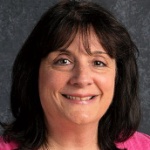Happy New Year!
 RoseMary Hunt
RoseMary Hunt
Math Teacher, Turtle Lake Elementary, Shoreview
Math Instructional Coach, Mounds View Schools
MCTM Region 4 Director
By the time you read this the new school year is underway and we are off and running! I always view September as “the new year.” It is a time for a fresh start, a time for reflecting on how to implement new learnings in our classrooms–new year’s resolutions.
Over the summer I rediscovered the book Accessible Mathematics: 10 Instructional Shifts that Raise Student Achievement by Steven Leinwand. The lens is pointed to “engage, and focus on understanding and application.” (p.2) In this time of heightened awareness and action to engage all students and to be culturally responsive in our classrooms, it makes sense to integrate Leinwand’s shifts.
The intentional shifts are (p.4-5):
1) Incorporate ongoing cumulative review daily.
2) Apply what works in our literacy program to our mathematics classroom.
3) Use multiple mathematical representations.
4) Create a language-rich classroom.
5) Develop number sense everywhere possible in the daily work.
6) Use data, graphs, tables etc to build lessons in problem solving and computation.
7) Increase the use of measurement and phrases such as “How big?” “How much?” “How far?” to naturally practice estimation.
8) Minimize what is not “important” and focus on what IS “important.”
9) Use real-world situations to get at the mathematics.
10) Require explanations of strategies to solutions for problem solving. “How do you know?” “Can you explain/justify your thinking?”
The district in which I teach has a three-year focus on literacy in the elementary grades. I have attended a number of literacy PD opportunities over the past year. And while I teach math all day, I can always find a way to connect the literacy practices to the math classroom as well. So it was no surprise to me to see #2 and #4 and #10 that directly relate to language and vocabulary. These shifts are intertwined. Are we focused so much on just what the “right” answer is? One-word (or number) responses should be followed up with an explanation or justification by the student. Students discussing different strategies; students writing their thinking. When presenting students with a situational story problem, include a box for their math work, and a “think bubble” for a place for them to justify/explain their thinking. “I multiplied,” doesn’t cut it. “Why did you multiply?” “What words in the problem led you to think about multiplication?” (inference in the literacy world).
Number Talks which is a current practice in mathematics classrooms at all levels, allows for this rich language experience as well. Given a pair or set of numbers, “How do you know these numbers are odd/even?” “What situations make sense for using these numbers?” Students can create their own math problem using the numbers given.
Build understanding around the vocabulary and the phrases used in a mathematical setting. Leinwand states, “….problems arise not from a lack of mathematical understanding, but from serious confusion with the English. That is , the terms and the vocabulary….language-rich classrooms are the best vehicles for helping ELLs prosper.” (p.28) Include the math vocabulary in the word wall in the classroom. Everyday review a few vocabulary words in the warm-up part of your math time. Find examples of these words, and counterexamples too. Use the words in authentic sentences. Use the vocabulary and its definition in the same sentence as you teach and ask questions.
Dismiss the responses of “wrong,” “no,” “not quite.” (p.70) Instead allow for student explanations of their thinking. This opens the door for self-correction on the part of the student, explanations are valued, perseverance to try again. For the teacher, these explanations allow us to identify misconceptions that students have and/or depth of understanding of the concept/skill.
I will visit a few more of Leinwand’s shifts in future Math Bits publications.
